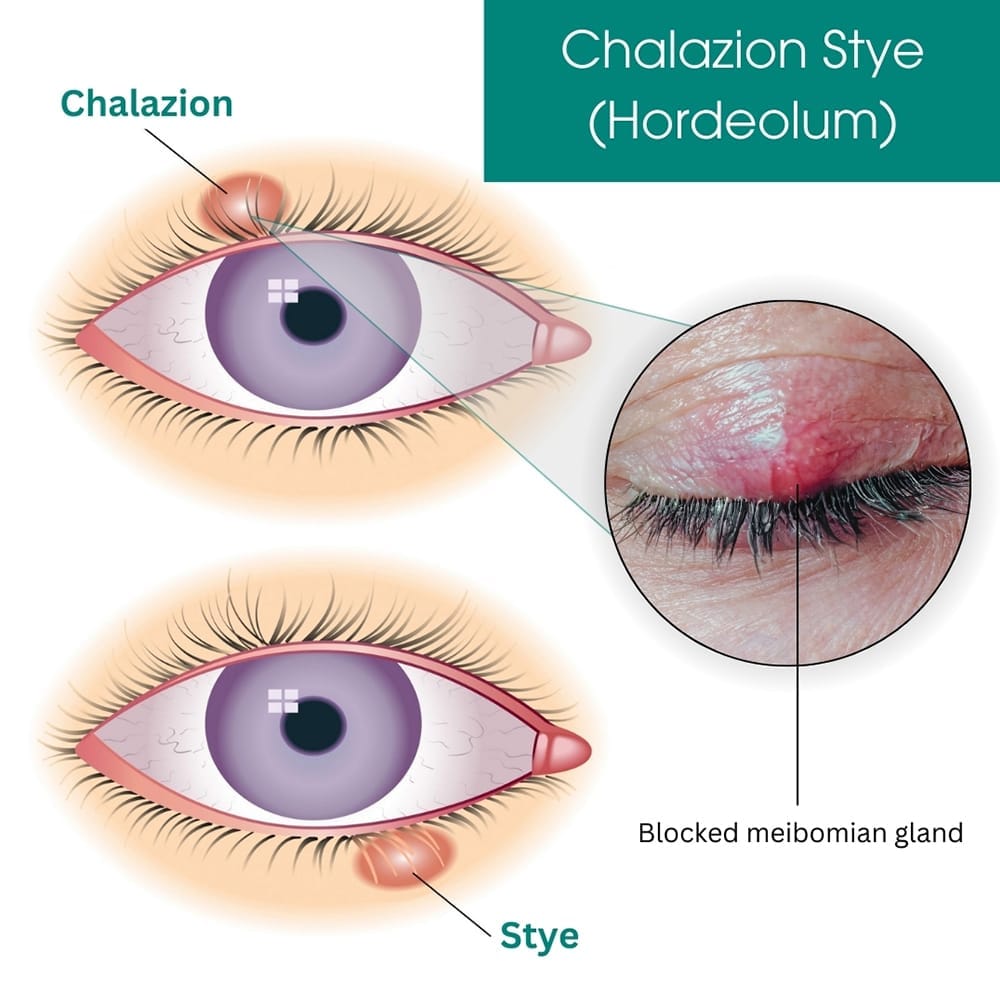 A chalazion stye, known by its medical term hordeolum, is a tiny lump that appears on your eyelid. It’s caused by a blockage in one of the eyelid’s tiny oil glands, called the meibomian glands. These glands create oil that’s necessary to lubricate your eyes. When a gland becomes clogged, oil builds up, resulting in irritation and creating a chalazion.
A chalazion stye, known by its medical term hordeolum, is a tiny lump that appears on your eyelid. It’s caused by a blockage in one of the eyelid’s tiny oil glands, called the meibomian glands. These glands create oil that’s necessary to lubricate your eyes. When a gland becomes clogged, oil builds up, resulting in irritation and creating a chalazion.
Both chalazion stye and regular stye are lumps on the eyelid. A chalazion is normally painless and caused by an oil gland obstruction, but a stye is typically unpleasant and caused by a bacterial infection.
Chalazion stye can occur in two different forms:
If you’re suffering from any type of stye, don’t ignore the discomfort. Seek immediate help from Eye Physicians in NYC for or expert care and relief. Their trained optometrists provide specific procedures to treat stye symptoms such as redness, swelling and irritation. With their knowledge and comprehensive approach to treatment, you can be confident in their ability to effectively recover your vision.
They also treat a wide range of conditions, including:
A hordeolum and a stye have several similarities in symptoms since they both involve your eyelids. You can only find out which one you have by visiting your NYC eye doctor.
Symptoms that may develop include:
The symptoms of chalazion styes are easy to identify. However, difficulties may occur in certain cases, particularly if the condition isn’t treated or if there are underlying medical issues.
Some potential complications may include:
The most common cause of a hordeolum is a bacterial infection, specifically Staphylococcus aureus. This bacterium is widely found on the skin and can quickly grow and cause inflammation if it reaches the oil glands of the eyelids.
Certain factors increase the risk of developing a hordeolum, such as:
Your hordeolum risk increases with eyelid conditions such as blepharitis or meibomian gland dysfunction, which affects oil gland function. Improper contact lens use can introduce bacteria and foster this infection. Hormonal changes during puberty, menstruation, pregnancy and menopause alter oil gland function, increasing hordeolum openness. Maintaining good eyelid hygiene, using proper contact lens care, managing stress, and recognizing hormonal effects can all reduce the likelihood of hordeolum formation.
A hordeolum is normally diagnosed after a physical examination of the affected eyelid by an experienced NYC eye doctor. They examine the eyelid for symptoms of redness, swelling, and a pus-filled lump. The doctor may also ask about symptoms including pain, discomfort, and any recent eye problems. In certain situations, further tests, such as drainage culture, may be used to identify the specific bacteria causing the infection.
Although it often heals itself after a week or so, there are chalazion stye treatments available to ease symptoms and encourage rapid healing.
Your eye doctor may recommend that you try treatments such as:
Symptoms such as swelling, soreness and redness are usually resolved within a few weeks with home remedies and minimal medical care. Early detection and treatment prevent consequences, such as secondary infections or corneal involvement. The severity of symptoms, as well as underlying health issues, may have an impact on recovery. Most people expect a positive outcome after visiting eye health experts at Eye Physicians.
Don’t let a hordeolum affect your vision. Contact the skilled doctors at Eye Physicians in NYC. With their experience, you can feel confident that the best optometrists will properly address your problem.
Eye Physicians
110 Lafayette St, Suite 503
New York, NY 10013
(212) 292-4814
Entrust the care of your precious eyesight to highly skilled and experienced eye care professionals. For top-notch ophthalmologists and optometrists in Downtown Manhattan, choose Eye Physicians. Eye Physicians ensures prompt care, precise diagnosis, and personalized treatment plans.
Schedule an Appointment